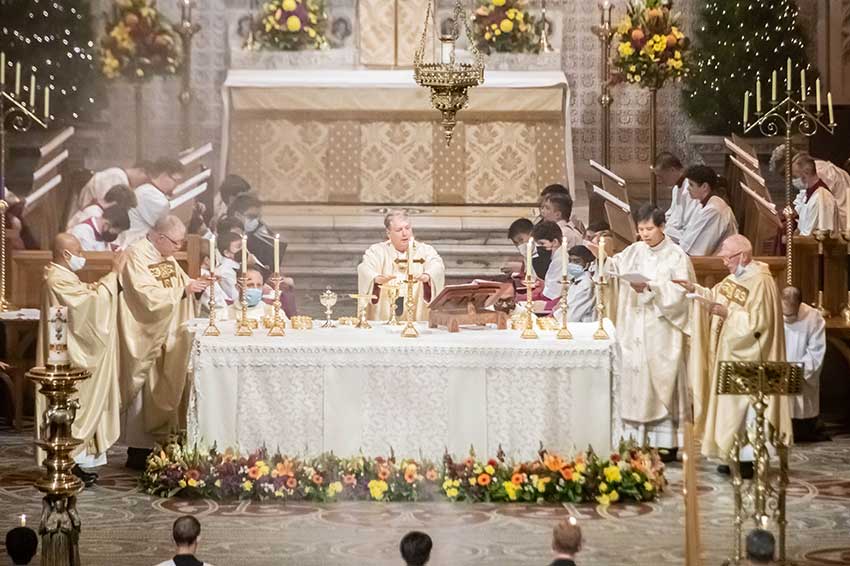
After six decades of “triumphs and traumas” since Vatican II’s Constitution on the Sacred Liturgy, Sacrosanctum Concilium, “significant aspects” of the reform are yet to be realised, ACU Professor Clare Johnson, will detail in a lecture at St Mary’s Cathedral on 29 November.
“Arguably, the most pressing of these is the provision of sufficient liturgical education for seminarians and ongoing liturgical formation for clergy, as Sacrosanctum Concilium called for,” Prof Johnson, Director of ACU’s Centre for Liturgy, told The Catholic Weekly.
The Council Fathers called for the study of liturgy to be given pride of place in seminaries and theological faculties, not just as a single subject but “as also the unity which underlies all priestly training.”
Priests should also be helped after ordination “by every suitable means … to live the liturgical life and to share it with the faithful entrusted to their care,” the council said.
The history of the reform is one of “triumphs and traumas,” Prof Johnson said.
She lists “active participation” among the chief triumphs of Vatican II’s reform, returning the church to “the pattern of prayer from the first centuries of the church.”
The expansion of the lectionary to include more Scripture at Mass, and the broadening of liturgical ministries to include lay men and women, have been two other strengths.
“When the liturgy of Vatican II is celebrated as it is supposed to be, when each participant enacts their role knowing what they need to do and when, well-trained and capable of performing their liturgical role beautifully, prayerfully, intelligently and with their mind attuned to their voice, we have a liturgy that achieves what it is supposed to, namely one that glorifies God and sanctifies humankind,” she said.
But “liturgical traumas” can result when the reform is not properly understood or enacted in light of further developments.
This could result from ignorance or the misinterpretation of the liturgical books, laws and documents that have emerged over the last six decades.
An overly-inclusive (but well-intentioned) attitude might also allow “external agendas” to intrude on the liturgy, turning it into entertainment or activism.
Likewise, settling for a poor standard of music can also be an impediment to prayer.
“When we settle for the lowest common denominator in terms of musical leadership rather than prioritising musical gifts informed by understandings of how music functions as a key part of the liturgical celebration, what results can be less-than-ideal music that doesn’t serve the needs of the worshiping assembly and often becomes a distraction rather than a powerful vehicle of prayer,” she said.
Prof Johnson said that Pope Francis has provided important leadership in navigating between extremes.
“Some choose to read SC as though nothing led up to its calls for reform and restoration of the sacred liturgy, but there was an extensive Liturgical Movement from the mid-19th century onward which foreshadowed the liturgical reforms and the work of which was affirmed by Pius XI in Mediator Dei (1947),” she said.
“Following SC are five instructions on its correct implementation by which successive pontificates have provided additional instruction on how to interpret and enact specific aspects of SC.
“Reading SC in a vacuum, without contextualising it in terms of what preceded and followed it can result in a simplistic reading that permits agendas from either the extreme right or the extreme left to be “read into” the document inappropriately.
“There is a need to balance the reforming, restoring, and conserving aspects of SC, which is a task that requires broad historical, theological, ecclesiological, and cultural knowledge and skill.”
Because the church is most itself when celebrating the Eucharist, the links between liturgy and the unity of the church are paramount, Prof Johnson added.
“Celebrating together with Christ as our Head shows us who we are called to be, namely, like Christ whose Word we hear proclaimed in the Gospel, like Christ who enters into us in Holy Communion and transforms us into his body when we gather as church,” she said.
“Pope Francis has striven in his pontificate to re-emphasise and realise the liturgical vision expressed by the Council Fathers in SC and has acknowledged the damage that can be done to the ecclesia if our liturgia is permitted to be a source of division rather than unity.”
